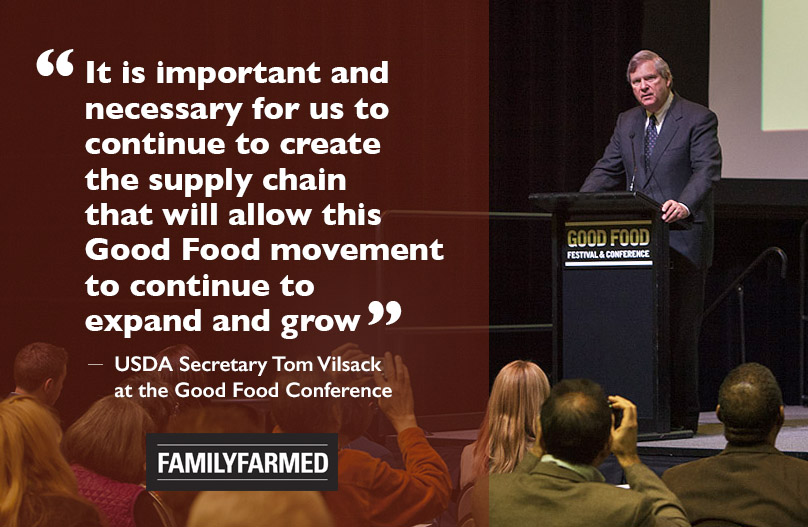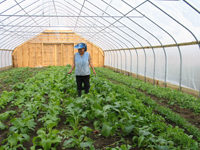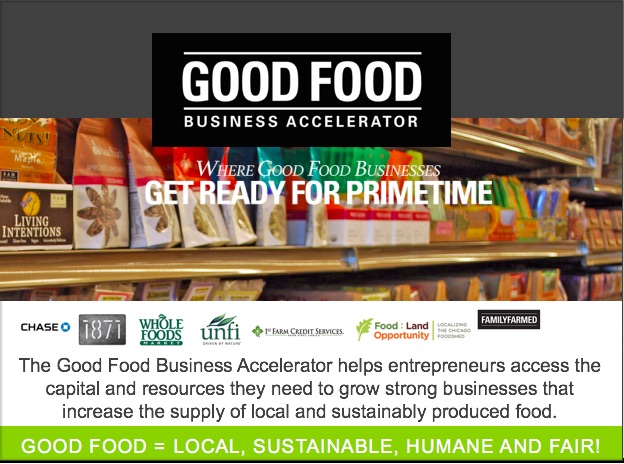by Bob Benenson, FamilyFarmed
When U.S. Agriculture Secretary Tom Vilsack delivered the keynote address at FamilyFarmed’s Good Food Festival & Conference March 24, he spoke three little words that are close to the hearts of the Chicago nonprofit organization and its community of like-minded advocates:
Good Food movement.
Though undoubtedly not the first time Vilsack had uttered the phrase, his use of it in the setting of the Midwest’s leading annual event promoting locally and sustainably produced food was profound — an affirmation from the highest levels of the U.S. government that the demand for a healthier, more environmentally sustainable and more economically dynamic food system has mass appeal.
USDA, in fact, reports that it invested more than $1 billion between 2009 and 2015 in nearly 40,000 local and regional food businesses and infrastructure projects. So it is not a surprise that Vilsack is comfortable enough with the phrase “Good Food movement” to use it three times in a speech of about 20 minutes long.

U.S. Secretary of Agriculture Tom Vilsack cited the “Good Food movement” during his keynote speech at FamilyFarmed’s Good Food Festival & Conference in Chicago March 24, using the full phrase three times. The first came during his acknowledgement of partnerships between USDA and FamilyFarmed to train farmers in best practices through the latter’s Wholesale Success program and On-Farm Food Safety Project, and to build entrepreneurial skills through FamilyFarmed’s Good Food Business Accelerator. Photo: Barry Brecheisen/FamilyFarmed
“All of this work is important and necessary for us to continue to create the supply chain that will allow this Good Food movement to continue to expand and grow,” Vilsack said.
He then described a brand new USDA product, created in conjunction with Colorado State University and released that day, called the Economic Impact Assessment Toolkit.
“It’s really designed to give us an ability to work with all of you so that you can make the case to local government officials, to investors, to those who are interested in the Good Food movement, that this is a profitable venture, that this makes economic sense,” Vilsack said. “We think this toolkit will enable you to make this case strongly and specifically, backed with data, which should lead to continued investment in the Good Food movement.”
He also said, in reference to the millions of Americans who lack resources or access to obtain healthful food: “We don’t think that anybody should be left out of this movement and this opportunity, which is why we have invested nearly $30 million of USDA resources in 48 states on a strategy to combat local food insecurity through an effort with locally and regionally produced food.”
Apart from this strong acknowledgement of the Good Food movement, Vilsack’s address was a historic moment for FamilyFarmed. While the fast-growing public interest in Good Food has drawn a number of leading policymakers to FamilyFarmed’s Good Food Festival & Conference, Vilsack’s visit was the first by a U.S. Cabinet member.
USDA has, in fact, developed a wide range of programs that work to the benefit of farmers (both experienced and new), food processors, buyers and consumers who produce, make and purchase Good Food. And the greatest surge of development has occurred since 2009, when President Barack Obama began his first term in the White House and appointed Vilsack, a former governor of the farm state of Iowa, to head USDA.
“They’ve done tremendous things to support folks like us and many other groups across the country to promote and build these entrepreneurial skills of local food farmers and entrepreneurs,” said Jim Slama, FamilyFarmed founder and president, in his introduction of Vilsack. These programs were discussed by Vilsack during his speech and by a following panel of leading USDA officials, titled “The Intersection of Public Policy and Good Food Entrepreneurship.”
The article below summarizes the remarks by Vilsack and the USDA officials. To view the Secretary’s full speech, please click on the video below produced by FamilyFarmed’s Jamie McCarthy.
Getting With the USDA’s Programs
USDA’s interest in promoting the growth of the local and sustainable food sectors obviously goes way beyond its partnerships with FamilyFarmed. Yet Vilsack, in his speech, said he felt the need to shine a brighter light on the department’s efforts in this sector. “I find in many audiences that I speak to that there is not a clear understanding of everything that USDA does,” Vilsack said.
His remarks focused heavily on USDA’s efforts to help producers build capacity. One program he touted strongly is administered by USDA’s Natural Resources Conservation Service and provides farmers with financial assistance to build “high-tunnel” greenhouses, covered growing spaces that protect crops from the elements and — especially in northerly areas with shorter outdoor growing seasons — better enable farmers to serve their local markets closer to year-round.

A photo of a high tunnel greenhouse from the USDA’s Natural Resources Conservation Service website. Photo: USDA NRCS
“Over 15,000 of those have been financed through USDA…,” said Vilsack, who had visited with farmers in southern Illinois who have added high tunnels with USDA support. “We’re seeing a significant increase in the number of farmers who are interested in these high-tunnel houses to extend the growing season.”
Vilsack noted that the first program developed under his tenure to address needs of smaller producers was a microloan program administered by the Farm Service Agency. The loan limit was initially set at $35,000, but the program proved so popular and effective that Congress raised the limit to $50,000 in the 2014 Farm Bill. Vilsack said nearly 18,000 farmers have taken advantage of the program since its inception in 2009.
He also said that this and other USDA programs represent the priority the department has to cultivate a new generation of farmers — the average age of U.S. farmers is currently near 60 — and promote demographic diversity in their ranks. “It is a good entry way to getting young people in particular engaged,” Vilsack said of the microloan program. “We have a concerted effort to try to encourage military veterans, women, people of color engaged and involved in farming.”
Another major point of emphasis was USDA’s efforts to expand access to healthy, nutritious food across socioeconomic boundaries, including the many low-income individuals and families who live in urban and rural “food deserts” where the opportunities to buy Good Food are very limited. This is an imperative that resonates strongly at FamilyFarmed, whose organizational motto is “Good Food on Every Table.”
Those receiving low-income food assistance under the Supplemental Nutrition Assistance Program (SNAP) program can now use their benefit cards to purchase locally produced vegetables and fruit at about 6,400 of the nation’s farmers markets, up from fewer than 1,000 when Obama took office. Vilsack said that, as a result, SNAP redemptions have increased from $3 million in the 2008-09 fiscal year to about $20 million in 2015.
“That’s an increase, of course, of revenue for farmers markets,” Vilsack said, “but I think more importantly it’s an opportunity for us to create a sense of community throughout the entire society in this country of people who have access to locally and regionally grown food.”
During a 20-minute speech, Vilsack also announced the new USDA Economic Impact Assessment Toolkit, and touched on USDA efforts that provide market-price-based crop insurance options for organic growers instituted under the 2014 Farm Bill, and offer cost-share options to help farmers transition from conventional to organic growing; help build entrepreneurial opportunity through the Value-Added Producer Grant program and assistance to food hubs; expand the amount of local foods provided to children through the Farm to School program; create directories to help locate farmers markets, Community Supported Agriculture (CSA) operations, on-farm retail outlets, and food hubs; develop data resources to help farmers determine how much to charge for their products; and work to reduce food waste in the United States through collaboration with other federal agencies.
Vilsack also got a chuckle out of the audience as he discussed USDA’s extensive food gardening projects that help provide fresh, nutritious produce to food assistance programs. Referring to the White House garden established by first lady Michelle Obama as the centerpiece of her efforts to promote better nutrition, health and fitness, Vilsack joked, “I was complaining about the attention the first lady has gotten for her garden. She has one garden, I have 2,100 gardens and I get no attention.”
He continued on a more serious note, “But we’ve got thousands of volunteers who work on these gardens, with the first lady’s leadership, and I’m proud that these gardens have produced about 3 million pounds of herbs and fruits and vegetables that can then be donated. Again, another way of connecting people with the community connection that I think food and local food is helping to create.”
Vilsack’s themes continued through the panel featuring USDA officials. This panel — introduced by Marianne Markowitz, the Midwest administrator for the U.S. Small Business Administration — included Sara Eckhouse, chief of staff of the USDA Agricultural Marketing Service, who moderated; Michael Alston, associate administrator of the USDA Risk Management Agency; and Sam Rikkers, administrator of USDA Rural Development. (The panelists are seen as listed left to right below. A video of the full panel discussion, produced by FamilyFarmed’s Jamie McCarthy, can be viewed by clicking the image.)
• Eckhouse said there is a symbiotic relationship between agencies and programs, noting that “some of the businesses USDA is funding through the Good Food Business Accelerator program with support from AMS actually have gone on to receive Value-Added Producer Grants.”
• Alston emphasized the benefits to organic producers of the recent introduction of contract pricing in determining reimbursements under the crop insurance program: “That means for those organic producers, if you have a contract, your guarantee will be based on that contract price… We understand that organics is highly labor intensive. We also understand the price point for organics.
• Rikkers underscored that there are financial set-asides in some of USDA’s programs, including one that dedicates funding to local and regional producers under the Business & Industry Loan Guarantee Program and another that sets aside money under the Value-Added Producer Grant program for new and beginning farmers and for farmers who are military veterans.
Even in the short time since the Conference, the USDA has announced additional assistance that will held build local food markets. An initiative called Food LINC (Leveraging Investment for Network Coordination) is designed to is designed to grow local and regional food economies through value chain development — or, according to a March 31 release from the National Sustainable Agriculture Coalition, “help rural producers and urban buyers ‘connect the dots’ between producers, aggregators, processors, distributors, and retailers.”
A partnership between USDA, the Appalachian Regional Commission, the Delta Regional Commission and 15 philanthropic organizations, Food LINC will initially use $750,000 in public money to leverage a total of $3 million in investment.
To learn more about the full range of USDA programs and grants to promote local, regional and sustainable food production, the department provides its “Know Your Farmer, Know Your Food Compass” on its USDA.gov website.
FamilyFarmed’s Role
Much of FamilyFarmed’s collaboration with USDA has focused on providing farmers with information resources and training that enables them to improve their production, harvest and postharvest handling, food safety, and marketing skills.
 USDA and its Risk Management Agency have partnered with FamilyFarmed on workshops based on the organization’s 315-page Wholesale Success manual aimed at small to medium-sized producers who sell into wholesale markets. Under this program, FamilyFarmed has trained more than 9,000 farmers in 40 states in best agricultural practices. “We have worked together to establish a program that focuses on better understanding of the wholesale market, the technical assistance that’s necessary for success there,” Vilsack said at the conference.
USDA and its Risk Management Agency have partnered with FamilyFarmed on workshops based on the organization’s 315-page Wholesale Success manual aimed at small to medium-sized producers who sell into wholesale markets. Under this program, FamilyFarmed has trained more than 9,000 farmers in 40 states in best agricultural practices. “We have worked together to establish a program that focuses on better understanding of the wholesale market, the technical assistance that’s necessary for success there,” Vilsack said at the conference.
FamilyFarmed also has partnered since 2010 with the Risk Management Agency on the On-Farm Food Safety Project, an online tool that facilitates efforts by small and mid-acreage fruit and vegetable farmers to comply with national best practices in food safety. The project, introduced at USDA headquarters in Washington, D.C. by then-Deputy Secretary Kathleen Merrigan, has become even more valuable to farmers, who face new regulatory requirements under the federal Food Safety Modernization Act and pressure from trade buyers to obtain food safety certification, and USDA is supporting technological and content improvements to the site.
USDA and FamilyFarmed also are working together to help food and farm entrepreneurs establish and scale up their business to increase the market for and the availability of Good Food products.
The Agricultural Marketing Service’s Local Food Promotion Program was a lead funder of FamilyFarmed’s Good Food Business Accelerator, a Fellows program for nine competitively selected entrepreneurs located in the Chicago foodshed with an intensive six-month curriculum, technical assistance, networking opportunities and connections to Good Food business financiers and lenders. The Accelerator is based at 1871, Chicago’s center for entrepreneurial innovation, which is located in the city’s historic Merchandise Mart.

FamilyFarmed’s Good Food Business Accelerator was founded in 2014 with lead funding from the USDA Agricultural Marketing Services Local Food Promotion Program. Two of the competitively selected Fellows in the program, Living Water Farms and The Cider Farm, have received direct assistance from USDA Rural Development’s Value-Added Producer Grants program.
The USDA has furthermore provided monetary grants under its Value-Added Producer Grants program to two businesses that have participated in the Good Food Business Accelerator: Living Water Farms of Strawn, Illinois, which is seeking to greatly expand its indoor growing facilities for herbs and microgreens, and The Cider Farm of Mineral Point, Wisconsin, which produces heirloom apples and uses them to produce hard ciders and a Calvados-style apple brandy.
FamilyFarmed was funded by the USDA Farm to School grant to help Chicago Public Schools more fully develop its local procurement program. In the past five years, CPS has purchased more than $13 million in food from local farmers. CPS is now sourcing antibiotic-free chicken from an Indiana Amish farmer, the largest purchase of its type in the U.S. CPS has worked with school districts in New York City, Los Angeles, Houston and Miami to encourage them to source antibiotic-free chicken. FamilyFarmed also partnered with CPS on “Eat What You Grow,” a school garden food safety project. Together, we created a school garden manual and training materials that allow CPS cafeterias to source produce from their own school gardens.
FamilyFarmed also is a leader in food hub development and has done extensive work researching and developing facilities that aggregate and/or process food. FamilyFarmed has helped launch Blue Ridge Produce in Virginia and the Wisconsin Food Hub Cooperative. Additionally, with USDA funding, FamilyFarmed published Building Successful Food Hubs: A Business Planning Guide for Aggregating and Processing Local Food in Illinois, a “how to” guide for entrepreneurs. Currently in the works is Food Safety for Food Hubs and Their Farmers, a technical assistance publication being produced in partnership with the USDA Agricultural Marketing Services.

While I totally appreciate the work that FamilyFarmed is doing, this article feels at little like green-washing. The USDA gives FAR more than $1 billion in assistance to conventional farmers through subsidies, crop insurance programs, etc. Furthermore, Sec. Vilsack has been heavily lobbying for a ridiculous watered down voluntary QR code GMO labeling scheme. And yet he’s totally off the hook in this article for any of this. The assistance that USDA has given small local and organic farmers is great. But they could be doing so much more! I think we need to do a better job of holding agency heads such as Sec. Vilsack accountable. He can’t just give a good talk in Chicago. He should be giving that talk and walking the walk every day from D.C.